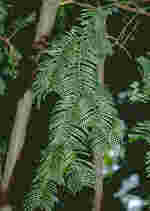 Foliage (3). | Cephalotaxus fortunei Hooker 1850Common NamesPlum-yew, Chinese plum yew (4), SanChianShan, LoHanShu, three-pointed fir (6).Taxonomic notesTwo varieties, the type (syn: C. kaempferi K. Koch 1858; C. fortunei var. concolor Franch. 1899) and var. alpina H.L. Li 1953 (syn: C. alpina (Li) Fu 1984) (5).DescriptionShrub or tree to 12 m tall, usually multistemmed, with an open, loosely rounded crown. Bark red-brown to dark brown, peeling in large scales. Branches, shoots slightly pendant. Buds small, covered with pointed, glossy, red-brown scale-like leaves which remain on the base of the shoot to the next year. Needles almost horizontally spreading, 5-11 cm long (longest in the genus), 1.5-4 mm wide, glossy, with a distinct midrib and 2 white to green stomatal bands below. Flowers appear in May. 'Fruit' olive-brown, ovate, 3.5-5 cm long, 1-1.5 cm thick (larger than most species), ripening in September. Chromosomes n = 11 are approximately isobrachial and one is heterobrachial with a trabant at the end of the short arm (4, 6). Var. alpina a shrub (6).RangeThe type variety is found in Burma; Viet Nam; China: Zhejiang, Hubei, Hunan, Guizhou, Sichuan, and probably several other provinces S of the Huang He (1, 2, 6). Variety alpina is confined to the mountains of Kham (W Sichuan and NW Yunnan) (5). Found in mountain forest to about 730 m elevation (1, 2); shade tolerant, USDA Zone 7 (6).Big TreeOldestDendrochronologyEthnobotanyObservationsRemarksListed as threatened in Viet Nam by the World Conservation Monitoring Centre.Introduced to Europe ca. 1849 and the U.S. ca. 1858 by Robert Fortune, who collected it in China (6). Citations(1) Silba 1986.(2) Museum of Natural History, Stockholm (online). (3) Hortus Botanicus Catinensis. (4) Vidakovic 1991. (5) Farjon 1998. (6) Kim E. Tripp. 1995. Cephalotaxus: the plum yews. Arnoldia 55(1): 24-39. |
[Cephalotaxus] [Cephalotaxaceae] [home] This page is from the Gymnosperm Database |